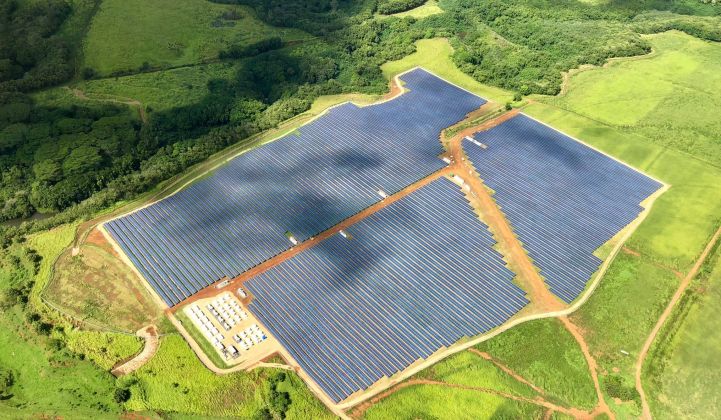Hawaiian Electric this week revealed the full list of winners from its second large-scale procurement of energy storage and renewables for the islands of Oahu, Maui and Hawaii. The winners run the gamut from major industry players like AES and Engie to relative newcomers to the large-scale energy storage game.
The contracts were first announced on May 15 without naming the developers, to give each an opportunity to communicate with communities near their project sites to negotiate local land-use issues before a broad public announcement.
The winners include:
- AES Distributed Energy, a subsidiary of U.S.-based energy company AES, which through its Fluence joint venture with Siemens has developed the world’s largest fleet of grid-scale batteries. AES won bids for two Oahu projects: a 30-megawatt/240-megawatt-hour system being built in conjunction with a 46-megawatt solar farm, and a 7-megawatt/35-megawatt-hour solar-linked system.
- Two French energy giants won bids to develop solar-battery systems on the Big Island of Hawaii, each to consists of 60 megawatts/240 megawatt-hours of storage: Engie North America, a large-scale renewable energy and storage developer owned by French energy and water project giant Engie, and EDF Renewables North America, the subsidiary of French utility and nuclear power giant Électricité de France.
- Hanwha Energy USA Holdings Corp. (formerly 174 Power Global), a U.S.-based unit of South Korean multinational and solar manufacturer Hanwha, won a bid for another 60-megawatt/240-megawatt-hour solar-linked battery system on Oahu.
- Wind and solar developer Longroad Energy won bids for two projects: a 120-megawatt/480-megawatt-hour system on Oahu, and a 40-megawatt/160-megawatt-hour system on Maui. Longroad was co-founded by Paul Gaynor, the former CEO of long-time Hawaii wind project developer First Wind.
- Bright Canyon Energy, a subsidiary of Pinnacle West Capital Corp., the owner of utility Arizona Public Service, will build a 42-megawatt/168-megawatt-hour battery system along with 42 megawatts of solar on Maui. Bright Canyon has primarily invested in wind power projects to date, including ownership stakes in Missouri and Minnesota projects being developed by Tenaska.
- Two other projects are being built by developers with deep-pocketed backers. Onyx Development, a commercial-industrial and smaller-utility-scale renewable energy project developer backed by Blackstone Energy Partners, won a bid for a 6.6-megawatt/26.4-megawatt-hour project on Oahu. And Pacific Green Ikehu, a subsidiary the SB Energy subsidiary of Japan’s SoftBank, plans to build a 40-megawatt/160-megawatt-hour project on Maui.
Several of the winning bidders had already disclosed their plans, which must still be approved by the Hawaii Public Utilities Commission. Those include Canada's Innergex Renewable Energy, which is building a 15-megawatt solar and 60-megawatt-hour battery system on Oahu and a 20-megawatt solar and 80-megawatt-hour battery system on Maui, and San Francisco-based Plus Power, which is developing a 185-megawatt/565-megawatt-hour project to provide storage and grid services to help replace the 180-megawatt AES coal plant on the west side of Oahu.
HECO is developing two projects itself — a 40-megawatt/160-megawatt-hour system on Maui and a 12-megawatt/12-megawatt-hour system on Hawaii. They were selected from five utility “self-build” projects that competed against third-party proposals focused on meeting the utility’s load-shifting and contingency services by the end of 2022, when the Oahu coal plant is set to retire.
HECO has structured its contracts to provide grid capacity and "dispatchable" renewable energy to manage grid stability after it closes the Oahu coal plant in 2022 and an oil-fired power plant on Maui in 2024. That makes for a more complex set of requirements compared to some of the large-scale renewable and storage procurements announced elsewhere in the U.S. in recent months, or HECO’s first round of contracts for 262 megawatts of solar and 1,048 megawatt-hours of storage in early 2019.
HECO is still in the process of picking winners of projects to provide customer-based grid services, such as fast frequency response and capacity, to help manage its rising mix of renewable energy and the loss of its baseload power plants. Those procurements, part of HECO’s Integrated Demand Response Portfolio plan, range from 4 megawatts on Hawaii to nearly 120 megawatts on Oahu, utility spokesperson Peter Rosegg said.
Correction: A previous version of this story incorrectly identified SB Energy as the backer of the Kaukonahua Solar project.




